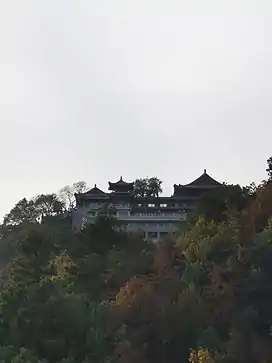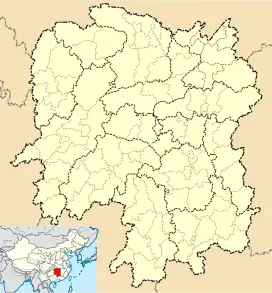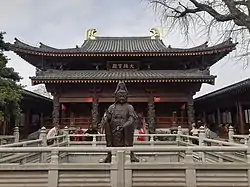| Mount Zhao | |
|---|---|
 Zhaoshan Temple on Mount Zhao | |
| Highest point | |
| Elevation | 185-metre (607 ft) |
| Coordinates | 27°58′26″N 113°01′01″E / 27.973871°N 113.017052°E |
| Naming | |
| Native name | 昭山 (Chinese) |
| Geography | |
 Mount Zhao Location of the mount within Hunan | |
| Location | Yuetang District, Xiangtan, Hunan, China |
Mount Zhao (Chinese: 昭山; pinyin: Zhāo Shān) is a 185 metres (607 ft) mountain on the border of Xiangtan and Changsha in Hunan, China.[1][2] Towering by riverside of the Xiang River, it has guarded the estuary of Xiang River and controlled the center of Hunan. It has been designated as a provincial-level scenery area by the government of Hunan in 1991 for its long history, superb environment, unique landscape and cultural attraction.
Etymology
It was named because King Zhao of Zhou (about 977/75–957 BC) paid a visit to it.[1][2]
History
With 3,000 years of history, Mount Zhao enjoys flourishing and profound culture.[1][2] Over 100 celerities indifferent dynasties paid a visit and left the descendants with over 150 poems and paintings, and some 70 ancient steles and architectural relics. In the Northern Song dynasty (960–1127), Mi Fu, a famous calligrapher and painter, painted The temple in the mountain, which was known as one scene of Eight Views of Xiaoxiang in ancient China and East Asia.[1][2] In the Qing dynasty (1644–1911), Wang Fuzhi and Wang Kaiyun used to climb up the mountain.
New it has been categorized as an AAAA-level tourist site by the China National Tourism Administration.
Culture
Zhaoshan Temple and Guanyin Temple are Buddhist temples on the mountain.[1][2]
Gallery
References
Bibliography
- Editorial Department, ed. (2016). "Scenic spots around Xiangtan" 湘潭周边景点 昭山 湘潭的北大门. Discoverer: Hunan 《发现者:湖南》 (in Chinese) (2 ed.). Beijing: Tourism Education Press. ISBN 978-7-5637-3373-6.
- Wu Boya (2017). "Changsha Zhuzhou Xiangtan area: Xiangtan" 长株潭地区:湘潭 昭山 潇湘八景山市晴岚的所在地. 走遍中国:湖南 [Travel All Over China: Hunan] (in Chinese) (3 ed.). Beijing: China Travel & Tourism Press. ISBN 978-7-5032-5846-6.

%252C_14_March_2021I.jpg.webp)
